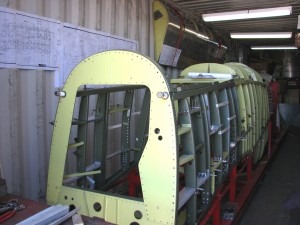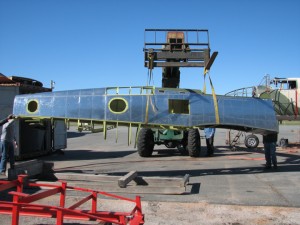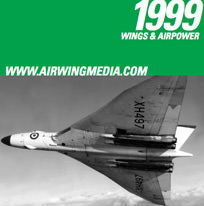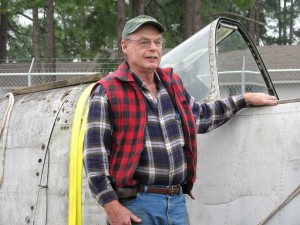Tom Reilly met Walter and Margaret Soplata in the early 90s when they asked him to do some IRS appraisal work for them. He received a wonderful guided tour throughout their whole facility and first saw a F-82 Allison-powered D model and immediately fell in love with the Twin Mustang series. Having been involved with bombers for his entire 40-year career restoring warbirds, Tom had never been keen on fighters, but it was love at first sight with the F-82. He mentioned to Walter in passing, “When you get ready to sell this F-82, I would like to purchase it,” knowing good and well that it would take years to save up the money to purchase the aircraft. It became just a passing fancy and knowing that it would never come true, he didn’t pursue the dream of purchasing that F-82.
 In 1997 Tom sold a flyable B-25 and all of a sudden he had the money to talk to the Soplatas about the F-82. He waited two days too long: they had just sold it to Doug Arnold in England, who in turn sold it to Wally Fisk in Anoka, MN. Tom knew his dream of ever owning a Twin Mustang was over.
In 1997 Tom sold a flyable B-25 and all of a sudden he had the money to talk to the Soplatas about the F-82. He waited two days too long: they had just sold it to Doug Arnold in England, who in turn sold it to Wally Fisk in Anoka, MN. Tom knew his dream of ever owning a Twin Mustang was over.
Fast forward to 2007.
Over the years Tom had prepared a number of additional IRS appraisals for the Soplata family, and, in December 2007, Tom was again called on to appraise a F-84 Thunderstreak. While on the Soplata property stomping through the snow, he looked behind a number of sheet metal roofing panels that were covering a fuselage and saw what he thought was a Mustang fuselage. When he said to Walter, “I didn’t know that you had another Mustang,” Walter informed him that what he was looking at was the prototype for the Twin Mustang. Tom asked if they wanted to sell it, and they said “No”. Tom said, “If you decide to sell it, please give me the first option.” They agreed and told Tom they would call him in the spring and talk about selling it.
Knowing that this would be his last chance to ever have a P-82, [P (Pursuit) was used until June 1948 when the designation changed to F (Fighter)], Tom started canvasing the world for P-82 parts, salvages and wrecks. He knew Dick Odgers in Alaska had bought a lot of F-82 scrap out of the salvage yard in Fairbanks and had rights to a hard crashed Twin Mustang. In south Florida, a friend of Tom’s had purchased three partial 82 fuselages, center sections and tail parts out of the same scrap yard.
 Not knowing what the price would be for the prototype XP fuselage and parts, and also not wanting those parts in Alaska and Colorado to get away, Tom put an agreement together to hold these parts, so that if he was able to purchase the fuselage and all of the other P-82 parts that the Soplatas had, he would have almost a complete P-82.
Not knowing what the price would be for the prototype XP fuselage and parts, and also not wanting those parts in Alaska and Colorado to get away, Tom put an agreement together to hold these parts, so that if he was able to purchase the fuselage and all of the other P-82 parts that the Soplatas had, he would have almost a complete P-82.
Tom, confident that he would be able to purchase the XP-82 prototype, put together a group of investors, knowing that it would be an extremely costly restoration venture and went about making plans to go back in business again to start on the XP-82 rebuild. (Tom had closed his Vintage Aircraft Restoration facility and museum in Kissimmee, FL, in 2004, after Hurricane Charlie completely destroyed his hangar and museum.)
 Come April 2008, Mrs. Soplota called Tom to say that they wanted to talk about selling the prototype. He went to Ohio, everyone agreed on a price and Tom and all of the investors were off and running on a new project that many people said could never be done. He loves putting award-winning restorations together that other people say are impossible.
Come April 2008, Mrs. Soplota called Tom to say that they wanted to talk about selling the prototype. He went to Ohio, everyone agreed on a price and Tom and all of the investors were off and running on a new project that many people said could never be done. He loves putting award-winning restorations together that other people say are impossible.
So, in July 2008, work in earnest started on the restoration of the XP-82 project. Eight first-class sheet metal employees where hired, all of Odgers’ parts were purchased and recovered from Alaska, and the parts were purchased and shipped from Colorado.
Two big problems emerged–finding a left-hand turning Merlin engine and a left-hand turning prop. Mike Nixon, Vintage V-12s in California, found a brand new left-hand engine in a garage in Mexico City and bought it. Tom contracted Nixon to build both the left-hand and right-hand turning Merlins for the 82 project. On the engine found in Mexico–how and why was it there? One will never know. MT Propeller, from Germany, agreed to build two composite props for the project, both left and right.
 Another big problem was that only the first 22 P-82s (2 XPs and 20 B models) had full dual controls. The parts recovered from Alaska or Colorado were all righthand fuselages from later models and only held a weapons systems officer with no flight controls . Tom called everyone in the warbird parts business who possibly could have any P-82 parts, and he was able to buy a number of good items, but no second cockpit controls. He called Michael O’Leary, editor for Air Classics, and Michael gave him the number of a man in the San Francisco area who had an entire left-hand side of a left-hand fuselage.
Another big problem was that only the first 22 P-82s (2 XPs and 20 B models) had full dual controls. The parts recovered from Alaska or Colorado were all righthand fuselages from later models and only held a weapons systems officer with no flight controls . Tom called everyone in the warbird parts business who possibly could have any P-82 parts, and he was able to buy a number of good items, but no second cockpit controls. He called Michael O’Leary, editor for Air Classics, and Michael gave him the number of a man in the San Francisco area who had an entire left-hand side of a left-hand fuselage.
Fall back to April 2008. While digging for parts throughout the Soplata facility, Walter came up with a windshield that he said fit the right-hand fuselage of the XP-82. Tom looked at it and noticed that it had square side windows where the XP-82 had curved windows, similar to a P-51. Right then one of Tom’s men called him on his cell phone saying that they had just found in the cellar the second windshield, belly scoops, radiators and the dog houses (radiator enclosures). Tom put the windshield down and made a mental note of it, and he and his men went about recovering the rest of the XP-82 parts, trailer loads of them!
 Back to July 2008. Tom called the man in San Francisco about the left-hand side of the fuselage, finding out that it had full controls, gear, flap, trim, throttle quadrant, etc. (nothing is the same as a D model Mustang), and asked if he would sell it. The man said no and that he would only trade it for P-51J parts. Never having heard of a P-51J, Tom was told that only two were ever built, and the man on the phone had the only remains of a J model and was in dire need of a windshield. “What does it look like?” Tom asked. “Send me a picture out of the parts book.” The impossible happened! The windshield that Tom had seen at Soplata’s was a J model windshield. (What are the odds?) Tom immediately went back to Ohio and purchased the windshield and traded it for the left-hand fuselage side.
Back to July 2008. Tom called the man in San Francisco about the left-hand side of the fuselage, finding out that it had full controls, gear, flap, trim, throttle quadrant, etc. (nothing is the same as a D model Mustang), and asked if he would sell it. The man said no and that he would only trade it for P-51J parts. Never having heard of a P-51J, Tom was told that only two were ever built, and the man on the phone had the only remains of a J model and was in dire need of a windshield. “What does it look like?” Tom asked. “Send me a picture out of the parts book.” The impossible happened! The windshield that Tom had seen at Soplata’s was a J model windshield. (What are the odds?) Tom immediately went back to Ohio and purchased the windshield and traded it for the left-hand fuselage side.
The project needed a second canopy, one that is completely different from any P-51 type, and a call came in that a woman in Tampa had a canopy that didn’t fit a Mustang, but looked like one. It was an 82 canopy, which was immediately purchased, and now, other than missing a few minor hydraulic components and outboard gear doors, which all can be manufactured, Tom’s crew has what can become a complete airplane.
(Someone has to be looking over them for them to have had the good luck to find all of the parts needed to complete the XP-82 project.)
 In two and a half years, Tom and his crew have made magnificent progress in bringing the XP-82 back to flying status. They still have a long way to go, but up to this date, they have completed the left-hand fuselage, both engine mounts, top cowlings, horizontal, elevator, both aft fuselage extensions and verticals, center flap,and landing gear and they are heavy into the rebuild of the right-hand fuselage, ailerons (four), rudders, and center section. Nixon’s Vintage V-12s has both right-hand and left-hand engines almost completed, and MT Propeller is well along building two propellers, a right-hand and left-hand.
In two and a half years, Tom and his crew have made magnificent progress in bringing the XP-82 back to flying status. They still have a long way to go, but up to this date, they have completed the left-hand fuselage, both engine mounts, top cowlings, horizontal, elevator, both aft fuselage extensions and verticals, center flap,and landing gear and they are heavy into the rebuild of the right-hand fuselage, ailerons (four), rudders, and center section. Nixon’s Vintage V-12s has both right-hand and left-hand engines almost completed, and MT Propeller is well along building two propellers, a right-hand and left-hand.
Projections are to have the XP-82 up on its gear with engines, props, wings and all tail surfaces completed with no internal systems, i.e., fuel, oil, glycol, electrical, etc., within 18-24 months.
It is amazing what has been found on the prototype parts prior to restoration. The crew found graffiti (“426 AD 4-6 rivet goes here” with an arrow) and another (“John, I will have the tickets for you tomorrow for the theatre”). These notes were apparently for co-workers on the next shift. Tom’s crew has documented and saved this graffiti to reapply it to the newly painted interior surfaces, and they have even gone as far as spectrographing the different colors of paints throughout the interior of the aircraft and have duplicated the colors exactly. They have also found and purchased the original WWII 442 head-style rivets to use in the restoration.
A common misconception is that the P-82 series were just two lengthened P-51H model fuselages put together on a common center section. In the two and a half years of working on the aircraft, Tom has found only two part numbers that are from the P-51 Mustang line; hinge points for the rudders and elevator, and a trim knob from a B-25. So the idea that one can use Mustang parts to help with the restoration of the XP-82 is definitely not the case.
Tom would like to thank everyone involved with all of the many aspects of this XP-82 prototype restoration who have helped us make this dream come true. Without the help from countless people, this project would have never become a reality.
About Tom Reilly
Tom Reilly has been in the warbird restoration business now for 41+ years after a chance first flight in a P-51 Mustang in Kissimmee in 1971. He got his start when a friend wanted to sell some North American Yale Training aircraft in Canada. He ended up buying 13 of them and restored five to flying condition. The next big project was a derelict B-25 in Caldwell, NJ. This aircraft was used as the camera ship for the film “Battle of Britain”, and then was abandoned for years. He bought the aircraft from all of the lien holders at the airport and, against all odds and nay sayers, got it to flyable condition. The B-25 started a love affair that Tom developed for bomber-type aircraft.
His big break came when he met Harry Doan from Daytona Beach, who graciously allowed Tom to fly his B-25 (after Tom restored it) to obtain his type rating. His next big break came when he got a call from Bob Collings to do a pre-buy and purchase on a B-25 in Washington state. This developed into a wonderful relationship where Tom restored not only the B-25, but the B-17 909 and the B-24 now named Witchcraft.
Tom’s specialty is taking on jobs that most other restorers say ‘can’t be done’. This was surely the case with the B-24 and the most recent rebuild, the B-17 for Don Brooks named Liberty Belle.
In the 41+ years of being in the business, Tom has performed 34 major restorations which included ten B-25s, three B-17s, one B-24, one F4U Corsair, a P-40 and nine T-6 (SNJ) aircraft. For 30+ years, Tom was located in the Orlando/Kissimmee area. Kissimmee was a P-61 and P-70 (A-20 night fighter) training base during WWII. In 2004, after Hurricane Charlie destroyed his restoration shop and museum, he moved to Douglas, GA, to work part-time for Don Brooks restoring his P-40E. In August of 2009, the P-40E was airborne and, in October 2010, a complete restoration of Mr. Brooks’ incredibly stock condition PT-17 Stearman was completed. It had sat idle in a hangar in Atlanta and had not flown for almost 40 years. The plane was restored and has the same markings of the 1940s flight training base aircraft here in Douglas.
The latest project that Tom has found is the North American Aviation XP-82 Twin Mustang prototype. This aircraft is only one of two that still exist in civilian hands and is being restored in Douglas.
Tom has provided many artifacts from his Flying Tigers Museum to the WWII Flight Training Museum in Douglas, GA.
Tom always remembers and thanks the many people that have contributed to his phenomenal success and international reputation as a restorationist.
For more information
- Visit the XP-82 Restoration web site.
- Wikipedia article on F-82 Twin Mustang.
- Like the XP-82 Restoration Project on Facebook.







